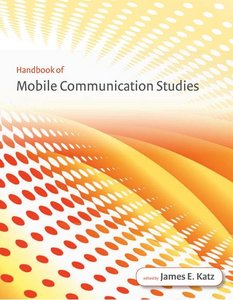Handbook of Mobile Communication Studies |

|
 Diese Seite wurde seit 1 Jahr inhaltlich nicht mehr aktualisiert.
Unter Umständen ist sie nicht mehr aktuell.
Diese Seite wurde seit 1 Jahr inhaltlich nicht mehr aktualisiert.
Unter Umständen ist sie nicht mehr aktuell.
 Zusammenfassungen
Zusammenfassungen
 Mobile communication has become mainstream and even omnipresent. It is arguably the most successful and certainly the most rapidly adopted new technology in the world: more than one of every three people worldwide possesses a mobile phone. This volume offers a comprehensive view of the cultural, family, and interpersonal consequences of mobile communication across the globe. Leading scholars analyze the effect of mobile communication on all parts of life, from the relationship between literacy and the textual features of mobile phones to the use of ringtones as a form of social exchange, from the "aspirational consumption" of middle class families in India to the belief in parts of Africa and Asia that mobile phones can communicate with the dead.
Mobile communication has become mainstream and even omnipresent. It is arguably the most successful and certainly the most rapidly adopted new technology in the world: more than one of every three people worldwide possesses a mobile phone. This volume offers a comprehensive view of the cultural, family, and interpersonal consequences of mobile communication across the globe. Leading scholars analyze the effect of mobile communication on all parts of life, from the relationship between literacy and the textual features of mobile phones to the use of ringtones as a form of social exchange, from the "aspirational consumption" of middle class families in India to the belief in parts of Africa and Asia that mobile phones can communicate with the dead.
The contributors explore the ways mobile communication profoundly affects the tempo, structure, and process of daily life around the world. They discuss the impact of mobile communication on social networks, other communication strategies, traditional forms of social organization, and political activities. They consider how quickly miraculous technologies come to seem ordinary and even necessary—and how ordinary technology comes to seem mysterious and even miraculous. The chapters cut across social issues and geographical regions; they highlight use by the elite and the masses, utilitarian and expressive functions, and political and operational consequences. Taken together, the chapters demonstrate how mobile communication has affected the quality of life in both exotic and humdrum settings, and how it increasingly occupies center stage in people’s lives around the world.
 Dieses Buch erwähnt ...
Dieses Buch erwähnt ...
 Personen KB IB clear | Sherry Turkle | ||||||||||||||||||
 Begriffe KB IB clear |  Mobiltelefon Mobiltelefon mobile phone
, mobile phone
,  Technologie Technologie technology
, Wearable ComputingWearable Computing technology
, Wearable ComputingWearable Computing
| ||||||||||||||||||
 Bücher |
|
 Zitationsgraph
Zitationsgraph
 Zitationsgraph (Beta-Test mit vis.js)
Zitationsgraph (Beta-Test mit vis.js)
 3 Erwähnungen
3 Erwähnungen 
- Rethinking Learning in an Age of Digital Fluency - Is being digitally tethered a new learning nexus? (Maggi Savin-Baden) (2015)

- ON/OFF - Risks and Rewards of the Anytime-Anywhere Internet (Sarah Genner) (2017)


- Aufwachsen im digitalen Zeitalter - Bericht der Eidgenössischen Kommission für Kinder- und Jugendfragen (Eidgenössische Kommission für Kinder- und Jugendfragen (EKKJ)) (2019)


 Co-zitierte Bücher
Co-zitierte Bücher


Hanging Out, Messing Around, and Geeking Out
kids living and learning with new media
(Mizuko Ito, Sonja Baumer, Matteo Bittanti, danah boyd, Rachel Cody, Becky Herr-Stephenson, Heather Horst, Patricia G. Lange, Dilan Mahendran, Katynka Z. Martínez, C.J. Pascoe, Dan Perkel, Laura Robinson, Christo Sims, Lisa Tripp) (2010)



Media in the Lives of 8- to 18-Year-Olds
(Victoria J. Rideout, Ulla G. Foehr, Donald F. Roberts) (2010)

 Volltext dieses Dokuments
Volltext dieses Dokuments
 Bibliographisches
Bibliographisches 
 Beat und dieses Buch
Beat und dieses Buch
Beat hat dieses Buch während seiner Zeit am Institut für Medien und Schule (IMS) ins Biblionetz aufgenommen. Beat besitzt kein physisches, aber ein digitales Exemplar. (das er aber aus Urheberrechtsgründen nicht einfach weitergeben darf). Aufgrund der wenigen Einträge im Biblionetz scheint er es nicht wirklich gelesen zu haben. Es gibt bisher auch nur wenige Objekte im Biblionetz, die dieses Werk zitieren.










 , 2062 kByte)
, 2062 kByte) 



 Biblionetz-History
Biblionetz-History